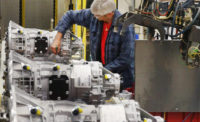CAMBRIDGE, England—Demand for printed, flexible electronic applications in the auto industry over the next decade will increase steadily to $13 billion, claims a new report from IDTechEx. According to "Printed and Flexible Electronics for Automotive Applications 2021-2031: Technologies and Markets,” three key technological transitions are behind this trend: electrification, autonomy and an increased focus on interiors.
“It is an exciting time for the automotive industry, with technological transitions toward electric vehicles and increased autonomy occurring simultaneously,” says Matthew Dyson, Ph.D., a technology analyst at IDTechEx who co-authored the report. “The ability to make electronics on thin flexible substrates enables weight to be reduced, a key consideration for electric vehicles. Furthermore, the conformality associated with flexible electronics is highly suited to emerging automotive interior design trends, with organic curves replacing flat surfaces.”
Dyson claims that “extensive opportunities for printed and flexible electronics are being created by the transition to electric and autonomous vehicles. These technologies include sensors within EV batteries; interior human-machine interface components and displays; new manufacturing methodologies, such as in-mold electronics (IME); and even exterior heating and lighting.
“Battery capacity is strongly dependent on temperature,” notes Dyson. “This creates an opportunity for printed arrays of temperature sensors to provide local monitoring and for printed heaters to be integrated within the same functional film.”
Increased levels of autonomy will also spur demand for printed, flexible electronics. “This creates opportunities for multiple sensor technologies and associated features, such as transparent heaters, integrated antennas and even low-resolution flexible displays for the exterior to interact with pedestrians,” explains Dyson.
“Already widely used in seat occupancy sensors, printed pressure sensors are likely to find their way into control panels to provide a wider range of inputs than purely capacitive touch sensors without the expense of mechanical switches,” adds Dyson. “Many of these touch sensors are likely to be produced via IME. By combining the electronics with the thermoformed plastic, it enables integrated systems, such as center consoles and overhead control panels, to be much lighter, simpler and easier to manufacture.”
IDTechEx predicts the market for automotive IME technology will surpass $1 billion by 2031.



